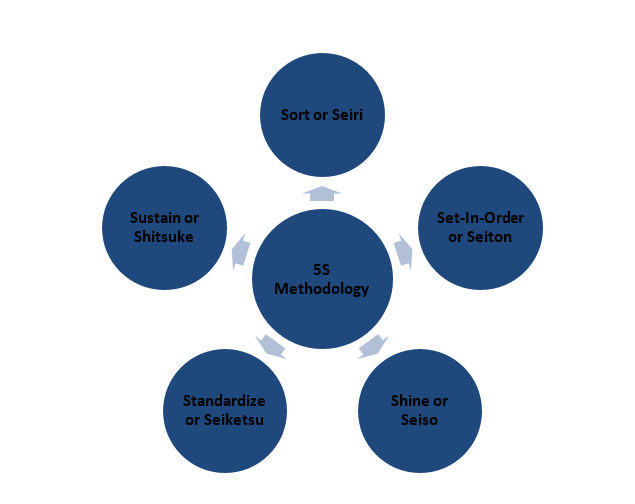
 Data Structure
Data Structure Networking
Networking RDBMS
RDBMS Operating System
Operating System Java
Java MS Excel
MS Excel iOS
iOS HTML
HTML CSS
CSS Android
Android Python
Python C Programming
C Programming C++
C++ C#
C# MongoDB
MongoDB MySQL
MySQL Javascript
Javascript PHP
PHP
- Selected Reading
- UPSC IAS Exams Notes
- Developer's Best Practices
- Questions and Answers
- Effective Resume Writing
- HR Interview Questions
- Computer Glossary
- Who is Who
Implementing the 5S Methodology
An organization has to start making plans for 5S implementation as soon as it decides the strategies that are appropriate for the business. Physical modifications to the space as well as instruction of staff members and other entities in the 5S methodology will be required for successful implementation.
Although it may take some time until 5S is completely implemented, there are considerable advantages all along the way.
What Is 5S Methodology?
The 5S method of visual management is methodical and makes use of every single thing, from as little as a floor tape to essentials like operations manuals. It's not only about keeping things tidy and organized; it's also about increasing productivity and profit. The 5S framework places an emphasis on using a certain attitude and set of tools to boost productivity and value. It entails doing waste removal exercises as well as monitoring, evaluating, working together, and looking for garbage.
Understanding the 5S Methodology
The 5S technique is based on five Japanese terms that begin with "S." They are easy to recall since their English versions likewise begin with "S." They are Seiri, Seiton, Seisou, Seiketsu, and Shitsuke in Japanese. These have taken on the following names in English -
Sort - Discard anything that is unnecessary
Set-in-Order - Arrange what is left once the sorting is done
Shine - Inspect and clean the workspace
Standardize - Create 5S standards
Sustain - Follow the 5S guidelines consistently

By developing and maintaining productive and efficient work environments, 5S activities fundamentally strengthen the discipline required for significant and ongoing progress.
Sort (Seiri)
Sort through the junk to start your 5S adventure. You can tell what is required and unneeded using this stage. This step's goal is to get rid of anything that isn't useful for your everyday tasks. Consider how using this item will benefit your day-to-day job. The amount of "stuff" you've been clinging onto can surprise you.
Having a sorting space to complete the Sort phase is also a good idea. Put anything in a temporary bin if you believe it might not be useful to you but can be utilized by your co-workers. This will give your team members a chance to study it and assist you in deciding if the object is necessary or can be thrown away.
Set-In-Order (Seiton)
It's time to organize things once you can see through the chaos. This step's objective is to make item retrieval simple for you and your team. Here, you need to concentrate on planning for useful storage. It is a good idea to keep objects you use regularly close at hand. Items that aren't utilized as often can be placed on a cabinet near your workspace. Items that are rarely used might be stored in an office cabinet on your departmental floor. Also, you may mark your storage spaces for convenience. Always remember to return objects after usage and to create a place for them all. Or else, you may find yourself starting again from step 1.
Also, analyze your office's layout at this phase. Is it functionally designed? Consider storing things to reduce your team's needless mobility. Organize your team's workstations to promote collaboration and comfort. Ask yourself whether it is simple to pass papers back and forth between team members or if they need to go across the room to get there.
Shine (Seiso)
It's essential to keep things nice and clean going forward. That doesn't mean that you'll have to sweep the office floor or clean your desk. Maintaining the structure you've established to maintain the cog operating efficiently is what Shine means.
To make sure that everything is where it should be, one method is to perform spot checks and routine inspections. It will be simpler to spot inconsistencies and waste if you maintain order. Being organized will allow you to rapidly fix these problems. Having someone authorized or in charge of inspection checks inside your department is another smart practice.
Standardize (Seiketsu)
A big congrats to you if you completed the first three steps. Your office is now better organized. You must develop habits if you want to truly implement the 5S model in your company. Furthermore, it's common to return to your old messy and chaotic behaviors when you're just starting out on your 5S journey. So, it's important to keep in mind that this isn't a seasonal cleaning activity you do once a year. For it to be effective, it must become your way of life at the office.
It's essential to follow certain rules and regulations to uphold the order you have created in the Standardize stage. When necessary, develop standard operating and documentation procedures. Adopt record-keeping guidelines, routine inspections, and 5S application schedules. The standardization of 5S in the workplace may undoubtedly be aided by reminders and certain other visual management techniques.
Sustain (Shitsuke)
Everyone in your company, from the CEO to staff, is required to support and participate in the 5S methodology implementation in order to ensure its sustainability. Consider implementing frequent communications regarding the company's 5S activity and rewarding people who are promoting 5S efforts.
Create manuals for 5S and conduct frequent evaluations with your staff. Ensure that new recruits are participating in the 5S program right away. In order to make sure that everyone working for the organization is abiding by those standards, frequent audits should be implemented. This will also highlight any areas that need work.
Advantages of Implementing the 5S Methodology
Among the main advantages of a 5S program are -
Eliminating surplus items and equipment from your facilities to make room
Structuring the workspace to reduce waste from needless mobility.
Reducing downtime and raising quality through routine equipment maintenance
Giving operators greater control over their workplace will engage them
Conclusion
5S may appear to be a straightforward idea. However, with correct and regular implementation, it can be an effective method to increase productivity. The reduction of waste, also known as "Muda" in Japanese, is one of the key advantages of applying 5S in the workplace. When your pipeline is organized and your workers are held to standards, you can anticipate higher-quality output. You reduce expenses, pointless effort, flaws, consistency issues, waiting times, and overwork in your organization.
Everyone can work more effectively when everything is well organized. Additionally, it makes your workplace safer for everyone. Thus, it enables you to expect higher levels of satisfaction and enthusiasm from your staff.

